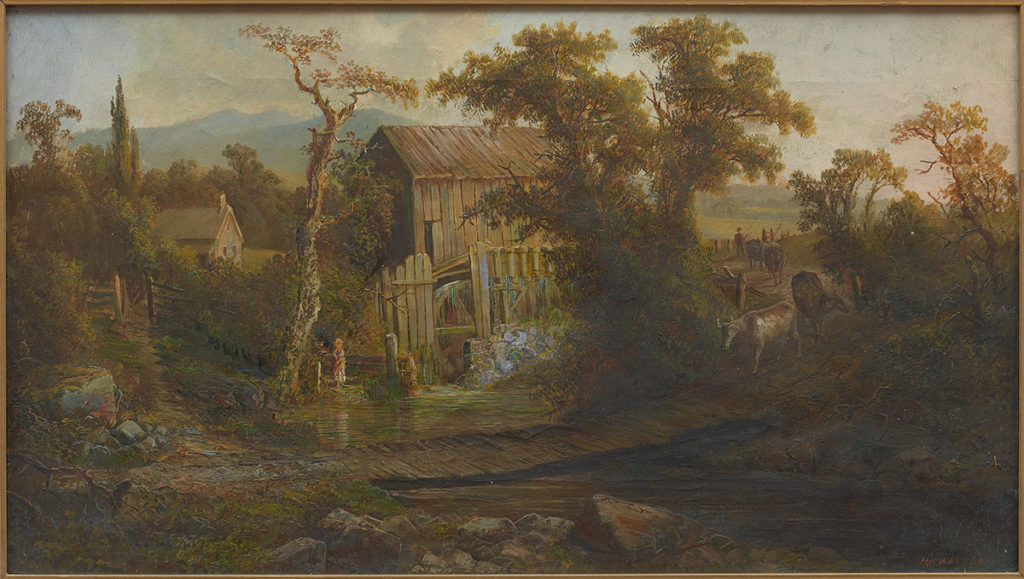Homer Watson: Environmentalism
Homer Watson had an emotional, even spiritual connection to trees. He noted that “It is like losing old friends once the trees go”[1] and even referred to tree cutting as “tree butchering”[2].
One of the artists’ most noticeable characteristics was his deep, soul-satisfying love of trees, and with the exception of a few allegorical subjects, trees have been the motif in every composition. The great hardwoods of his native Doon, the oaks and elms, the beeches and maples, he painted with sympathy and understanding, arrangements simple in design but wonderfully fine in pattern and infused with depth and movement.[3]
One of his favourites was an old elm on his property, and a family story goes that Homer sat outside with a shotgun when neighbour Jacob Cluthe threatened to have it cut down.[4] The elm wouldn’t meet its end until 1954, when its massive trunk began to spilt and was at risk of falling onto the parked cars of Doon School students.[5]
His passion eventually extended outside of his artwork and into what we would refer to as environmentalism.
Homer lived during an age where the landscapes of rural Ontario were drastically changing. Art historian Brian Foss speculates that the reoccurring imagery of decaying mills found in Homer’s artwork can be read as both nostalgic of pioneer life as well as “displaying the consequences of upsetting balance between human needs and nature’s capacity to regenerate itself.”[6] Technological advancements such as the implementation of telephone poles and wiring throughout the countryside were also upsetting to the artist, and he expressed publicly in the Galt Daily Reporter that the land’s “beauty spots” had been “sacrificed to cold materialism”.[7]
We have sleet storms and wind, but the elements are mild in their power of destruction compared with telephone, telegraph, and last and worst, the Hydro-Electric butchers; for nature, if left alone, would soon mend what she mars. It makes one rage to see to see how apparently wanton these men can be.[8]
Aside from his beloved elm, one of the areas that Homer was most protective of was Cressman’s Woods. It was originally owned by the Cressman family, descendants of early Swiss settlers in North America who had maintained the area of unique trees for several years. Canada yew, white pine, hickory, yellow birch, beech, white elm, black cherry, prickly ash and more were all a part of the tract.[9]
By 1913, the area was set to be put up for auction, and the principle interested party was a sawmiller. Motivated into taking action, Homer gathered several like-minded community members – such as Daniel Bechtel Detweiler and David Forsyth – in an effort to purchase the property and save it. George Tilt bought the land, and together the group formed the Grand River Park Company with Homer as its president. In a speech to shareholders of the Company, Homer not only praises the natural beauty of the area but also makes note that “too great a clearance of forest tracts creates a peril for future generations in aridity”[10], meaning that a loss of trees would result in negative effects on the soil.
It took them about two decades to repay the mortgage, but over that time the Company built a lookout platform, labelled trees, added picnic tables, and generally encouraged the care of the land. [11]
The woods, with their numerous varieties of rare and stately trees, bearing labels indicating both their common and botanical names, and their splendid cathedral effect, were the subject of much comment and the promoters came in for high praise. The panoramic view of the Grand River valley from the observation platform, the scene of the first settlement of Waterloo County proved of special interest to the visitors, most of whom were unaware of the beauties of the Grand River valley in this district.[12]
Homer resigned the presidency in 1921, but his efforts saw a working balance left in the treasury and was satisfied with how things had turned out.[13] The property would eventually be transferred to the City of Kitchener, where it remains today as Homer Watson Memorial Park.
[1] Homer Watson, “Letter from Homer Watson to Mortimer Lamb”, 1909, Homer Watson House & Gallery Archives
[2] Homer Watson, “Appeal Made to the Despoilers of Nature”, Galt Daily Reporter, 1913
[3] Ross Hamilton, foreword to Homer Watson Artist and Man, (Kitchener: Commercial Printing Company, 1939), vi
[4] Jane VanEvery and Ruth Whiting, “Homer Watson – RCA-LLD” (Lecture, Wilfred Laurier University, Waterloo, October 25, 1974)
[5] “150-Year-Old Tree May Be ‘Given the Ax’”, Kitchener-Waterloo Record, November 24, 1954
[6] Brian Foss, Homer Watson: Life & Work, (Toronto: The Art Canada Institute) 2018
[7] Galt Daily Reporter, 1913
[8] Ibid.
[9] Ernie Ronnenberg, “Part of Doon Pioneer Village on the Isaac Cressman Farm”, Kitchener-Waterloo Record, October 23, 1976
[10] Homer Watson, “Conservation of Cressman Bush for Waterloo County”, Homer Watson House & Gallery Archives
[11] Rych Mills, “Watson helped save woods from sawmill”, Waterloo Region Record, 2015
[12] “Large Brantford Delegation Inspected the Cressman Woods”, Berlin Daily Telegraph, September 30, 1915
[13] Muriel Miller, Homer Watson: The Man of Doon 2nd ed. (Toronto: Summerhill Press 1988), 102





